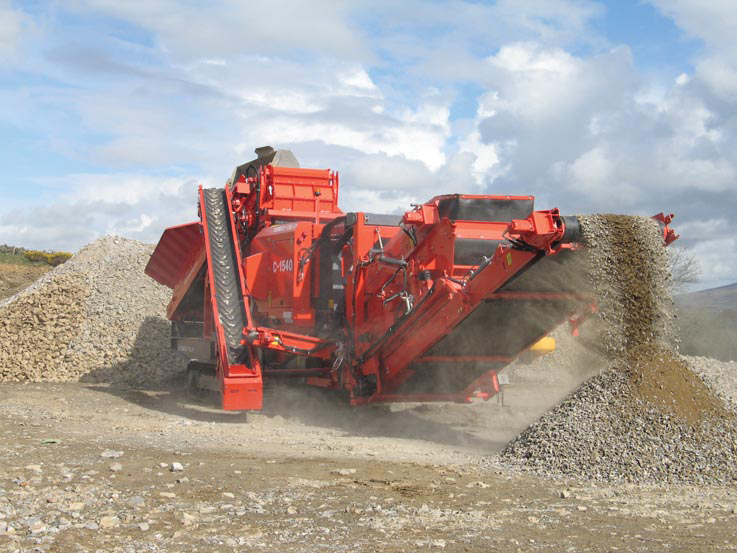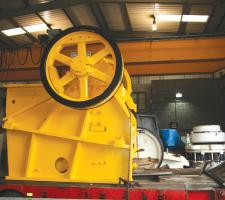
Reduced capital expenditure plans means that more quarries are opting to rebuild and repair crushing equipment rather than invest in new machines
Difficult economic times call for a different approach to business, and for the crushing market this is driving greater acceptance of repaired or rebuilt machines. Even where funds exist for new investment, this is currently more focused on the mobile market to ensure full flexibility.
"We are seeing a trend in people choosing to repair their crushing equipment, rather than replace it," said
Investment value
But it is not just smaller quarry operators and those in emerging markets that are starting to take the repair option more seriously. "We recently repaired a crusher for an
"The timescale for a rebuild will depend on what needs to be done - a bearing failure could take up to a week but other repairs may take several weeks. But most breakages can be avoided through correct lubrication and not asking the machine to work outside of its original design parameters." UK-based Blue Spares has said that it has also seen increasing activity in the rebuild and refurbishment market and described the trend as "rebuilding and refurbishing old but faithful plants to give them a second life".
According to Hodges, many quarries now have to rely on contract maintenance rather than in-house specialists due to budget constraints. He said, "Taking the cheap option may seem favourable but is rarely a good long term investment."
Budget issues are also changing the approach of some aggregate producers to spare parts as well as refurbishment. "Quarry groups that were once loyal to one OEM are now considering using after market parts as they can offer considerable cost savings, depending on the part, but are manufactured to the same standard," explained Hodges.
Service life
"Larger quarry customers are also focusing on durability and reliability by ordering machines and parts with hardened steel and rubber liners to prolong service life." Despite the economic climate, Nethery reported a good first quarter for the sector and said that customers are trading in old machines for new and there is a ready market for second hand machines still.
"Finance is an issue when it comes to investment at the moment but demand will return," he said. "There will be a slight delay from when the stimulus packages get underway but crushing and screening equipment will be needed to meet the demand for aggregates.
"Some very big operators now take the view that certain quarries are their key ones in a specific region and will invest in fixed plant in those, but are now opting for mobile plant in others to give them more flexibility. The current economic climate seems to have accelerated this trend as it is easier to fund new mobile plant than larger fixed units." The level of enquiries is also still high and Nethery believes that many operators are now taking time to review what's available rather than concentrating on working flat-out. "They recognise that the return will come and are getting ready to make the necessary investment when it does," he said.
New developments
"For Sandvik the top priorities in design are the environment and health and safety, but for customers the focus is on productivity and reliability to reduce the cost per tonne," explained Nethery.
"More mature markets are looking for machines with a higher degree of automation, whereas emerging markets want simplicity. To this end, Sandvik has recently started to produce wheeled units from its Indian manufacturing base, which Nethery says meets demand from India, the CIS and Eastern Europe.
"There is more need now to make a wider range of specifications to suit customers' needs. One or two years ago demand outstripped supply but now we are looking more closely at what machines suit which markets. Customers are now being more demanding and selective rather than just taking the machines that are available." Demand for more flexibility from mobile units is already starting to shape the functions of new equipment. "We are offering more and more machines with recirculation conveyors and even had one customer waiting for two years before ordering his new mobile crusher as he wanted to wait until his current model had been updated with a recirculation system," said
"These kinds of conveyors are common on screening equipment but we have started to develop them for the crushing range, first with the J1175 impactor and later on some cone models. The recirculation conveyor creates two machines on one platform, which is a more efficient use of resources. The recirculation system was developed in response to customer demand. We are now looking at the next development of this as we think it has a significant role in Europe, particularly for recycling." According to Nethery, aggregate specifications will also drive changes in the crushing equipment sector. "Infrastructure projects that demand higher specification aggregates are likely to drive development of more mobile VSI machines over the next five years," he said. "Many dam projects will not accept material unless it is VSI processed and this will spread." Emissions legislation is also likely to influence the design of the next generation of crushing equipment. "Introduction of Tier 4 engines from 2012 will also present some issues in terms of fuel and design," said Dunn. "Some regions do not have access to the right octane fuels but the need for after treatment will mean the engine and urea tanks will take up more space within the chassis. Not only will this add to operational costs but also to the daily maintenance routines." Dual power options will become more common to allow use of diesel and electric power, according to Dunn. In some countries quarries have access to reduced electricity costs, or there are concerns about fuel contamination. The potential to switch between power sources also has benefits for contractors.
However, Dunn also believes that the need for greater efficiency will also shape the specification of machines. "The improvement in fuel economy won't come just from different engines but will come through alternative drive systems," he said. "At the moment most of our machines use hydrostatic drives because they are reversible but direct drive from belts could offer higher efficiency. This will not be an option for recycling operations where the possibility of tramp metal requires the ability to reverse the feed, but quarry operations with good fragmentation and size control could make use of this energy saving effectively." But whether the approach of choice is repair, rebuild or replace, it is clear that there are plenty of options open to quarry operators to help continue production.
















